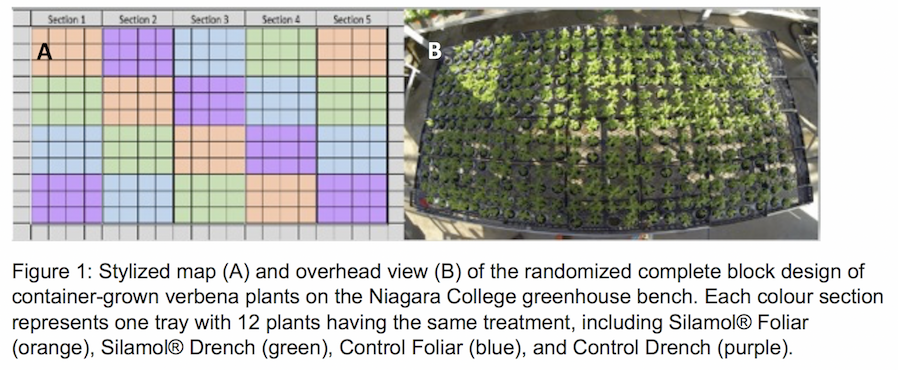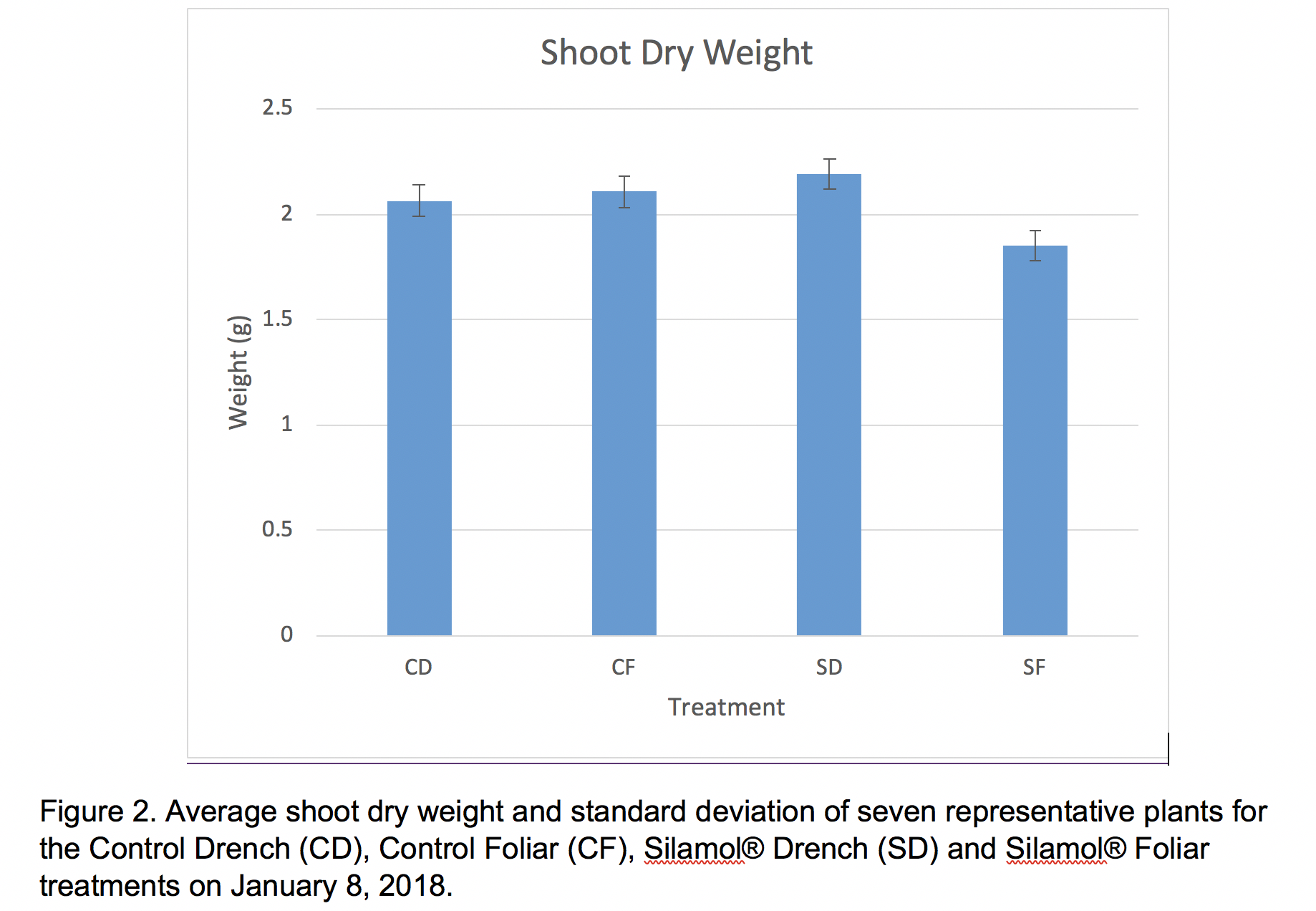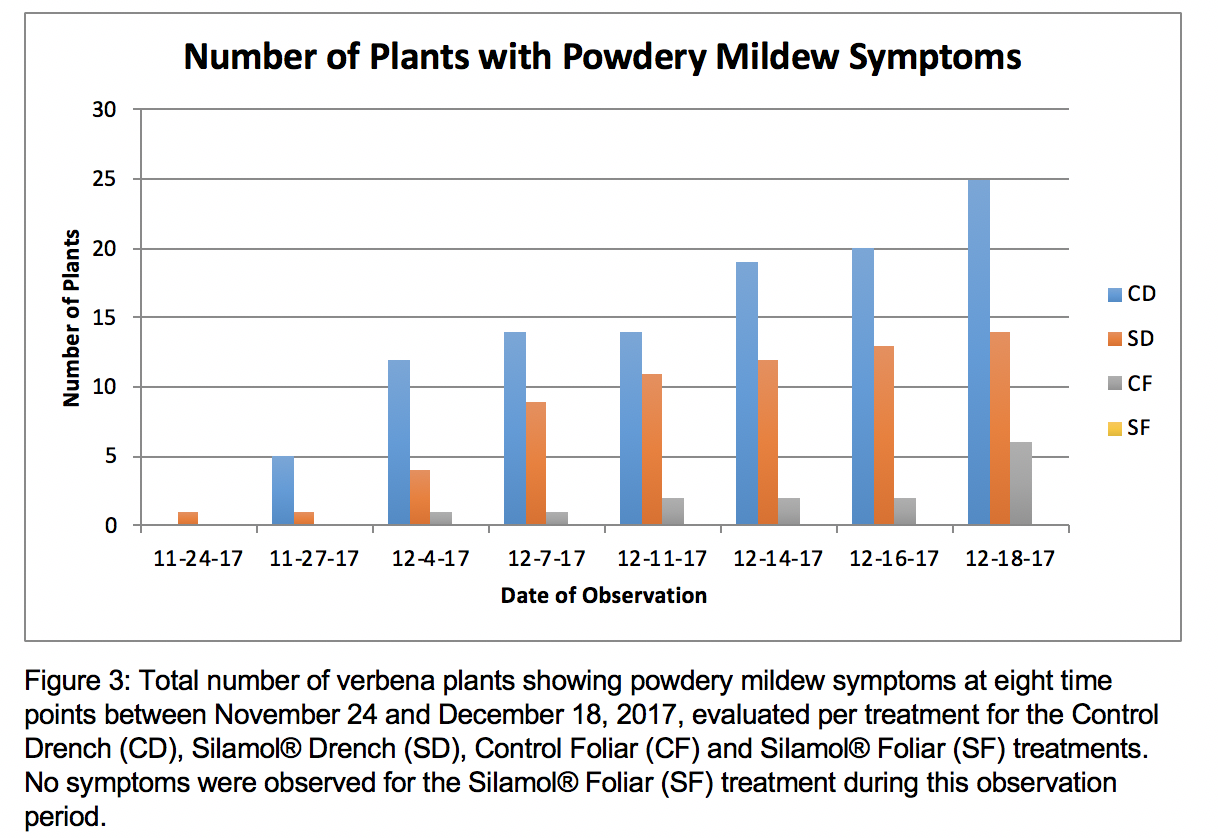
Features
Crop Protection
Inputs
Silicon effective against powdery mildew in verbena
Niagara College researchers evaluate the efficacy of Silamol in reducing disease incidence and severity for Verbena x hybrida.
March 11, 2019 By Mary Jane Clark Evan Hadley and Charlie Laporte
 Photo caption: Student researchers (L-R) Evan Hadley and Charlie Laporte with Frontline Growing Products Canadian Distributor Dave de Haan and Niagara College Horticulture Professor Mary Jane Clark with verbena plants from the research study in the Niagara College, Niagara-on-the-Lake Campus greenhouse.
Photo caption: Student researchers (L-R) Evan Hadley and Charlie Laporte with Frontline Growing Products Canadian Distributor Dave de Haan and Niagara College Horticulture Professor Mary Jane Clark with verbena plants from the research study in the Niagara College, Niagara-on-the-Lake Campus greenhouse. From October 4, 2017 to January 8, 2018, a research project was conducted at the Niagara College, Niagara-on-the-Lake greenhouse to evaluate the efficacy of Silamol, a silicon product designed to help reduce the negative impact of biotic and abiotic stress in plants.
Silamol is a highly-concentrated, stabilized form of a potassium silicate liquid. Once completely diluted in water, Silamol produces [Si(OH)4] known as monosilicic acid, the only known plant-available form of silicon (Frontline Growing Products, 2018).
While silicon is one of the most abundant elements in the soil, it’s not always available to plants. Naturally-occurring microbes transform the silicates into silicic acid, which is taken up by the plant. However, growing media does not usually contain these microbes. In addition, greenhouse crops are grown and harvested in a matter of weeks or a couple of months, so speed of uptake and bioavailability of silicon are critical. By providing a plant-available form of silicon (i.e. monosilicic acid), it can be quickly absorbed by the plant.
Silicic acid has three main benefits:
- Increases and balances uptake of nutrients: In a process called “biochemical sequencing”, the microbe-converted silicic acid must first be taken up by the plant before absorbing calcium, organic nitrogen, magnesium, phosphorus and potassium – in that order. If one element in this sequence is not (or less) available, the uptake of other elements becomes more difficult, leading to possible nutrient deficiencies.
- Builds structure and physical resistance against stress: The silicon is deposited into the outer layer of the plant cell, creating a more rigid barrier against pests, pathogens and environmental stress.
- Stimulates the plant’s immune system: The presence of silicic acid helps trigger the production of immunity compounds in the plant, while incorporating silicon to help rebuild and strengthen plant tissue in the areas under attack.
The research study evaluated the efficacy of Silamol in reducing the incidence and severity of disease in a greenhouse-grown potted Verbena (Verbena x hybrida Quartz XP series) crop. Verbena was chosen by a local greenhouse producer as the ideal crop for this study, due to its high susceptibility to disease, especially powdery mildew.
Experimental design
All plants were grown on the same bench in the Niagara College, Niagara-on-the-Lake Campus greenhouse, using no supplemental lighting. The average greenhouse temperature during the study was 21°C, and the average relative humidity (RH) was 70%.
On October 4, 2017, 240 verbena plants were transplanted from seedling plug trays into 4” containers, filled with a shredded wood fines growing substrate (Gro-Bark, Caledon, ON). The containers were evenly spaced on the bench in 20 trays, each containing 12 planted containers. Each tray contained plants assigned to one of four treatments, arranged in a randomized complete block design on the greenhouse bench, with a total of 60 plants per treatment (Figure 1).

Treatments were applied weekly to all four treatments for the duration of the study, beginning October 24th, 2017. Silamol applications were mixed at a ratio of 15 mL of Silamol concentrate per 12L of water. 100mL of the solution contained 0.125mL of Silamol concentrate.
The treatments include:
- Silamol Foliar (SF): 100 mL diluted Silamol applied by a foliar spray method
- Silamol Drench (SD): 100 mL diluted Silamol applied by a growing substrate drench method
- Control Foliar (CF): 100 mL tap water applied by a foliar spray method
- Control Drench (CD): 100 mL tap water applied by a growing substrate drench method
Measurements
Plants were monitored for visual symptoms of disease from October 4, 2017 until December 18, 2017, with disease incidence (i.e., the number of diseased plants) evaluated at eight time points during this observation period. At the completion of the study on January 8, 2018, disease severity was ranked on a scale of 0 (no disease) to 10 (fully diseased).
Above-ground shoot growth, for each of the seven representative plants per treatment, were placed into paper bags on January 8, 2018. Bags were dried at 70°C until a constant weight was achieved.
Results: Plant Growth
The greatest average verbena shoot dry weight was observed for the Silamol Drench treatment (2.19g), while the Silamol Foliar treatment had the lowest average shoot dry weight (1.85g). The average shoot dry weight for both the Control Drench (2.07g) and Control Foliar (2.11g) treatments were mid-range for the plants in this study (Figure 2). By January 8, 2018, plant growth had filled in the containers and some plants were beginning to flower.
The difference in growth between the drench and foliar applications of Silamol might be one factor for growers to consider when evaluating the best application method for this product.

Results: Disease and Pest Symptoms
The number of plants with visible powdery mildew symptoms increased over time for the Control Drench, Control Foliar and Silamol Drench treatments during 2017 (Figure 3). By December 18, 2017 the Control Drench treatment had the greatest number of plants showing powdery mildew symptoms. However, when comparing plants with the same treatment application method (i.e., drench or foliar), the incidence of powdery mildew symptoms tended to be greater for both control treatments, compared to both Silamol treatments. In addition, both treatments with a drench application method showed a higher incidence of powdery mildew compared to the foliar application treatments
At the end of the study (January 8, 2018), powdery mildew symptoms were observed on some plant leaves of verbena in all treatments. The average powdery mildew disease severity ranking, based on a 0-10 scale, was greatest for the Control Drench (4.0) and Control Foliar (3.2) treatments and lowest for the Silamol Drench (2.6) and Silamol Foliar (2.0) treatments.

Conclusion
In summary, of the four treatment methods, a weekly foliar spray application of Silamol seemed to offer the best protection of greenhouse-grown verbena foliage from initial incidence as well as severity of powdery mildew symptoms. When compared to the control treatments, a substrate drench application of Silamol also displayed better protection for powdery mildew symptom severity. Overall, this study indicates weekly foliar Silamol applications could be useful for greenhouse verbena growers to prevent the incidence and severity of powdery mildew symptoms within the crop, with the potential for a drench application of Silamol to increase verbena shoot growth during production.
Acknowledgements: This research was coordinated by the Niagara College Research & Innovation team, and was generously funded by OCE CVTA and Frontline Growing Products. Plant material was kindly supplied by Schenck Farms & Greenhouses Co., while Gro-Bark kindly supplied the growing substrate.
Mary Jane Clark is professor of horticulture, and Evan Hadley and Charlie Laporte are student researchers at Niagara College. For more, contact Mary Jane at marclark@niagaracollege.ca.
Print this page